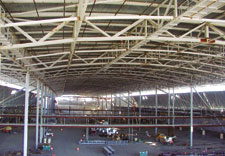...negotiate rather than start again. The process went well, says Davis. In every case, at the end of the day, we selected the low bidder.
 |
| BIG EXHIBIT The exhibit hall has windows, high ceilings and architectural expressed trusses, unlike most convention centers. (Photo courtesy of Walter P. Moore) |
Budget woes may have raised the projects profile, but the architects massing plan, which minimized roof elevations and broke down the scale, did not. The 1,100 x 480-ft exhibit hall is flanked on its two long sides with three-story buildings, designed to mimic South Bostons residential triple-deckers. The side buildings contain 200,000 sq ft of meeting rooms.
The hunkering down of the building was helped by an elevated access road from the west. The continuation of the viaduct elevation around the convention center, like an airport terminals ring road, makes the 1,600-ft-long roof, which slopes south to north from 75 ft above grade to 123 ft above grade, appear only 100 ft above the street at the main entrance. The east and west meeting room roofs are only 58 ft above the ring road but 81 ft above grade. This two-level ring road camouflages the loading docks along one side of the building.
 |
| (Photo courtesy of Clark Construction) |
Nobody believed it could be built, approved and supported by the communities, says Vinoly, who admits the architecture is about pragmatism, not poetry.
If there is any drama in the building, it is packed into the exhibit hall. Unlike the typical black, windowless, flat-roofed box with 30 or 40-ft ceilings, the 516,000-sq-ft hall has a high central roof with architecturally expressed trusses and windows to let in natural light. Though the room ranks ninth in the U.S. as far as continuous space, it probably holds the record for ceiling height.
 |
| WALKWAYS Glass-enclosed bridges span exhibit hall and act as hangers for room dividers. (Photo courtesy of HNTB/Rafael Vinoly Architects) |
The roof plan consists of two low sections, 90 ft wide and 45 ft high, flanking the high roof. Dividing the high roof at third points are 300-ft-long, glass-enclosed pedestrian bridges. The walkways act as hangers for operable partitions that can divide the hall into three rooms. Motorized shades and drapes will allow exhibitors to black out daylight or views from above.
The steel-framed high roof is carried on sixteen, 300-ft-long transverse truss arches supported by two lines of 30-in.-dia pipe columns, unbraced as much as 80 ft, that create a 180-ft center span with 60-ft end cantilevers. Trusses 30 ft on center span 90 ft in the opposite direction. Truss top chords match the roofline. Bottom chords are shaped to match the moment diagram of the span.
|
The high-roof diaphragm has four in-plane diamond braces (click here to view chart). They provide lateral stability by transferring loads from the high roof to the [robust] low-roof structure through four, vertically oriented diagonal braces, says Peter J. Cheever, vice president of LeMessurier Consultants Inc., Cambridge, Mass. The structural engineer is associated with the Tampa office of Walter P. Moore & Associates Inc.
The low roof is supported by 90-ft-long transverse trusses, 7.5 ft deep, that bear on tree columns, with four branches, each 40 ft long, that provide stiff lateral resistance. The branches keep the number of columns taking up floor space to a minimum, says the engineer. They also make the bay size more like a 60-ft-square, though columns are 90 ft apart. That helped support heavy loads of ceiling mechanical equipment.
Because of land acquisition issues, construction proceeded south to north, zigzagging from one side to the other, instead of north to south. The CM would have preferred moving north to south because of proximity to the access road, electric...

Post a comment to this article
Report Abusive Comment